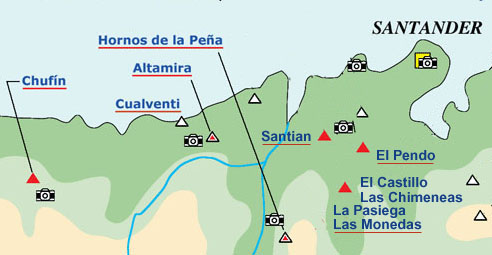Photo Archives: Paleolithic Art in Northern Spain
Hornos de la Peña
Preview Edition
- 8 photos(about1280x1000,1470x980/JPEG).
- Commentary by César González Sainz & Roberto Cacho Toca, Univ. of Cantabria.
- Royality Free for private and educational use.
In this downloadable photo archives are contained 8 photos of Paleolithic cave art of Hornos de la Peña cave with the archeological data and commentary as shown in this preview pages. Only the small sized reference images and a part of commentary are shown in this preview edition, but if you are interested to see more and to use these photos, please go to Kagi store and purchase the data package. Once payment has been made at the Kagi store, you will receive an e-mail containing the URL to download the data package. All photos that are contained in this package are ROYALITY FREE for private and educational use.
Hornos de la Peña
 Cueva de Hornos de la Peña is situated in the hill known as "La Peña", near the village of Tarriba, in the municipal district of San Felices de Buelna. The entrance is in the small, narrow valley of the River Tejas, 60m above the river-course, but this, only a few kilometers to the north, joins the wide, open plain of the Buelna valley.
Cueva de Hornos de la Peña is situated in the hill known as "La Peña", near the village of Tarriba, in the municipal district of San Felices de Buelna. The entrance is in the small, narrow valley of the River Tejas, 60m above the river-course, but this, only a few kilometers to the north, joins the wide, open plain of the Buelna valley.
The cave art in Hornos de la Peña was discovered in 1903 by the great explorer of the archaeology of the region Hermilio Alcalde del Rio. It was, therefore, one of the first caves with parietal art to be known in Europe. Three years later, this researcher included the cave in a small book together with the studies he had made of other Paleolithic art sites: Altamira, El Castillo and Covalanas. In 1911 it formed part of a major publication on Cantabrian cave art: Les cavernes de la region Cantabrique, written by the discoverer of Hornos de la Peña in collaboration with the prehistorians H. Breuil and L. Sierra. This 1911 publication remains the main reference to the parietal art in the cave. During those early years of the century, in 1909 and 1910 to be precise, archaeological digs were carried out in the vestibule of Hornos. The scientists of the Institut de Paleontologie Humaine at Paris documented an important stratigraphic sequence, with Mousterian, Aurignacian, Solutrean, and Magdalenian industry, and also Neolithic artifacts. Among the objects recovered was a piece of mobiliary art: a fragment of a horse's frontal bone, decorated with the rear-quarters of precisely a horse, and this enabled stylistic and chronological correlations to be made with the art on the walls inside the cave.
----------------------------
[References]
Alcalde del Rio, H.; Breuil, H.; Sierra, L. 1911. Les cavernes de la region Cantabrique. Imp. A. Chene. Monaco.
Ucko, P.J. 1987. Débuts illusoires dans l'étude de la tradition artistique. Bulletin de la Société Préhistorique Ariége-Pyrénées 42, pp.15-81.
|
Photographed by Takeo Fukazawa & Co-Project Team of Texnai Inc. and the University of Cantabria
Commentary by César González Sainz & Roberto Cacho Toca, Univ. of Cantabria
Texnai Inc.:
2-1, Udagawa-cho, Shibuya-ku, Tokyo, Japan. Tel:03-3464-6927 Fax:03-3476-2372
e-mail:info@texnai.co.jp
Copyright reserved by Takeo Fukazawa &Texnai, Inc., University of Cantabria, IPA
|
|